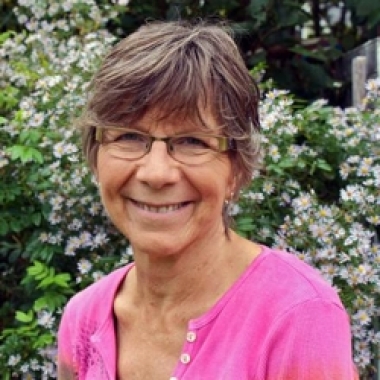Who is Susan Carlson?
Over fifty. Married. One college-aged son. Furred and feathered pets (if you follow me you're bound to find out more than you'd ever want). Grew up in suburban Maryland just outside of DC. Now reside in Harpswell, Maine.
Currently teach quilting nationally and internationally. Developed my own technique of fabric collage quilting which I have explained in depth in two books, Free-Style Quilts and Serendipity Quilts. I usually teach at retreats, quilting guilds, or fabric shops, but I also run retreats here in my hometown.
I've been creating art with fabric since 1983 while attending the Maryland Institute, College of Art. There, I used any excuse I could to use fabric as an art medium for my illustration assignments. I painted on fabric, inked, dyed, drew with thread, did traditional piecing, appliqué and reverse appliqué. My influence was my mom, who trained as a dressmaker and seamstress. From her I inherited my love of fabric. I think it's the tactile nature of it. My husband has more than once noted that when I shop for fabric, my hands are as busy fondling fabric as my eyes are drinking in the pattern and color.
As I continued to experiment with fabric for a few years after college, I yearned for something more immediate, more like painting and less like construction. In 1990 I drew on my collage skills, though this time with fabric and not paper, though still using glue. Since I had approached quilting from an art direction rather than a traditional one, I didn't realize how out-of-the-box gluing fabric was. A true quilter was not supposed to glue. But that's what I did, and I've never looked back. And there's even raw edges! As you may have figured out, I don't worry too much about what I'm not supposed to do.
I grew up in a crafty household with parents who like to "figure things out" and made things to sell. My mom sews and my dad does woodwork. The first decade of my career (the 1990s) I spent a lot of time making small quilts—16 x 20 inches or so—to sell. My first ones were mostly of fish—I must have made a thousand of them. I started to teach my fabric collage process in 1994 and slowly the teaching overtook the production of pieces for shows or galleries. These days I concentrate on making the quilts I want to make, usually for myself, unless they're commissioned. I make on average one big quilt a year allowing me to put a lot of myself into every piece. They're not usually for sale, but I do submit them into quilt shows, and use them as examples for my teaching.
By the end of 2016, I will have spent fifteen weeks teaching. For a homebody like me, that's a lot. I try to limit teaching to one week per month on average. But between prepping for a trip, travel, teaching, and recovering from a trip, each week of teaching actually uses up about two weeks of my time and energy. Which helps to explain why the remainder of the year I want to concentrate on my own work.
How do I do what I do? The way I approach it is to treat bits of fabric as dabs of paint. I cut pieces of fabric freehand (or use scraps as I find them) and use craft glue (Aileen's Tacky Glue) to tack the fabric in place. That's really all there is to it. Often creating an image involves layering one fabric on top of another, sometimes using translucent tulle or other netting, until the desired effect is achieved. I free-motion machine quilt using a BERNINA 1530 home sewing machine.
I don't use templates. I refer to photos to create a sketch onto plain fabric—flannel or muslin, for example. I then fill in the sketch with those bits of fabric. If I'm doing an animal, I may start at the head, since that's the most expressive part. I like to play with color, often ignoring "natural" colors, but I pay strict attention to value. Darks and lights, highlights and shadows. Value is what gives the piece form.
Occasionally the background of an image will be one solid piece of fabric, but most often I continue collaging into the background as well.
Growing up I considered three career choices: artist, teacher, or veterinarian. I studied at an art college, becoming a quilt artist who teaches fabric collage and creates quilts mainly of animals. Funny how things work out.
I'm a very hands-on teacher. When I work with a student, I don't stand back and lecture about what they should be doing. If needed, I'll take their scissors and show them what I mean. I am also a coach—encouraging, cajoling, critiquing. Since fabric collage is often very different from anything they've done before, students sometimes lack confidence. Giving them that confidence is part of my job.
Rather than simply teaching a particular technique, I try to teach students to see, truly see. To look at whatever they are creating and ignore what they assume something looks like and really examine it. Again, value is critical. Where are the highlights? What shape are the shadows? An eye probably isn't round. A nose has a shadow under the tip.
Students often wonder how they will know when they're done. When is a piece finished? For me the answer is easy: when I run out of time! No, seriously, I could always add more. More detail, more color, more texture.
More is better!
I encourage my students to keep going. Keep adding layers. Keeping defining features.
Rich: that's the word. I want my students to make their pieces rich. Not flat. Full of interest. Not bland. There's enough bland stuff in the world. No need to add to it.









